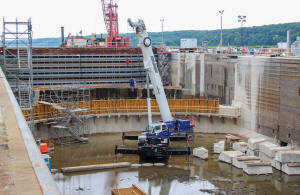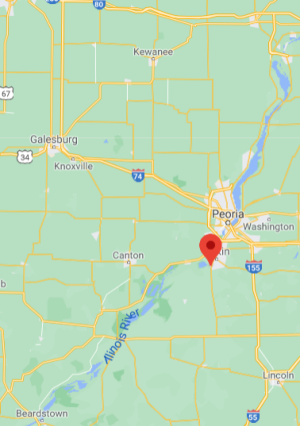|
 Starting in 2019, the Army
Corps of Engineers began an ambitious project of updating and
refurbishing aging infrastructure along the Illinois River. Nine
total locks and dams are scheduled to be upgraded with new concrete,
gates, docking and machinery. Starting in 2019, the Army
Corps of Engineers began an ambitious project of updating and
refurbishing aging infrastructure along the Illinois River. Nine
total locks and dams are scheduled to be upgraded with new concrete,
gates, docking and machinery.
The aging infrastructure of the Illinois River system is the oldest
in the nation and the last to receive attention and maintenance. It
was built during the 1920's depression by CCC workers and was
operational in the early 30's, operating for almost 90 years without
significant maintenance.
In 2019, the Army Corps closed two locks for a short period, in 2020
closed five locks and dams to all boat traffic and the Corps will
close two more in 2023 for needed maintenance.


Lock
construction image from The Waterways Journal
The significance of these lock closures: agricultural products that
depend on the Illinois River to get to the Mississippi and down to
the south Louisiana port near New Orleans are backed up and waiting
for the river to reopen.
Of the five major ports, New Orleans is the busiest agricultural
port in the United States, exporting some two million metric tons of
U.S. grain products to the rest of the world. The Illinois River
provides access to about 35% of the total Ag tonnage received in
Louisiana each year, and this year barge traffic on the Illinois is
closed from July 1 thru October 31. Corn, soybeans and animal feed,
along with ethanol, petroleum, and building materials like cement,
stone, sand and lime halted on July 1st when the five locks closed
for business.
Year 2020 is slated to be the biggest Ag products export year that
the U.S. has ever experienced, and the Illinois River producers have
had delayed access to the international markets. China not only
increased its purchase of soybeans this year, but in an unusual move
has also ordered a significant amount of feed corn due to
significant flooding in their Ag production areas in late 2019.
While the U.S. has been getting drier, China has been getting
wetter.
China has already purchased 77% of its 2020 U.S. grain quota,
fulfilling its pledge made in recent trade negotiations with the
Trump administration.

The result of China's binge buying is that grain prices are up
significantly, but Central Illinois' basis is tanked. Some elevators
have even been forced to store soybeans on the ground awaiting the
opening of the river passage. Trucking and train cars have been
used, but have increased the cost of shipping, and the full harvest
flow of central Illinois grain is backed up waiting for the port at
Havana to reopen to barge traffic.

LaGrange lock and dam
at Beardstown. Image from Innovative Contracting and Engineering
In 2019, 406,000 tons of grain flowed through the southern LaGrange
locks at Beardstown from January 1 through June 30, and this year
that amount has more than doubled to 999,000 tons hurriedly
preparing for the lock closure.
The original plan, barring extensive flooding, was for the locks to
reopen on October 15, 2020. But the construction process took a
little more time than expected and all locks are now scheduled to
reopen by October 31.
[Note:
The locks were officially re-opened on October 29th]
The five locks receiving maintenance in 2020 are Dresden Island lock
and dam at Morris, Illinois, Marseilles lock and dam, Starved Rock
lock and dam in Utica, Peoria lock and dam, and the LaGrange lock
and dam at Beardstown. Maintenance at Dresden Island will resume in
2023 as well as refurbishment of the locks at Brandon Road in
Joliet.

Snipped map
from Google Map Data https://goo.gl/maps/vSa5kmRcDNRjNjQE6
[to top of second column] |
 On the Illinois River
system, the dams are designed to restrict flooding and reserve water
depth at a minimum of eight feet for barge and river traffic. The
course of the river has been changed: originally the river flowed
north into Lake Michigan. It was changed to flow south to connect
Chicago to the Mississippi river. At Chicago the elevation of the
river is at 577 feet above sea level, at Brandon Road in Joliet 539
feet, at Dresden Island in Morris 505 feet, 483 feet at Marseilles,
458 feet at Starved Rock, 440 feet at Peoria, and finally at 430
feet at the LaGrange lock and dam at Beardstown. The locks are
designed to raise and lower boats and barges to gain access as the
elevation decreases so significantly from north to south.

Image from DTN
Progressive Farmer
The Corps selected the summer months for the project to provide the
best chance of avoiding work delays from spring floods and take
advantage of lower shipping volumes during that time to have as
little impact on the navigation industry as possible. The Corps also
wanted as little disruption as possible to the flow of Ag products
from the 2020 fall harvest. The Illinois Waterway System averages
13.3 million tons of cargo that passes through this lock system each
year.

A few unusual things have happened during this maintenance process.
One of them happened during the dewatering process at the Starved
Rock locks. The locks were so full of Asian carp that the pumps
became clogged and the whole processed stopped until commercial
fishermen could remove all the carp so the dewatering process could
continue.

Image from
Prairie Rivers Network
The Army Corps carefully planned and communicated before the
maintenance with barge companies, materials companies, and Ag
companies like Growmark, ADM and Cargill about this disruption of
the river transportation system so that all would know what to
expect and plan for all the eventualities caused by these closures.
The Corps has planned the next closures for 2023 in order to give
companies added time to recover from the 2020 closures.
All in all, material handlers, Ag exporters and barge lines are
thrilled with the Army Corps and these Illinois waterway
improvements which mean that their products can flow more
efficiently down the Illinois and into the Mississippi for years to
come.

Early in October 2020, U.S. Rep. Darin LaHood, R-IL along Marcel
Wagner, President of with the Great River Economic Development
Foundation announced federal funding and infrastructure investments
to develop three Corn Belt Ports for Quincy, Peoria and the Quad
Cities to gain expedited access to the Mississippi river. The Peoria
Corn Belt port on the Illinois river will help lower transportation
costs and increase access to international markets for Central
Illinois and Iowa producers.
These five locks are scheduled to reopen to traffic on October 31st,
three days after this magazine comes out, and handlers at all
Illinois River ports are ready for action.
[Jim Youngquist]
|